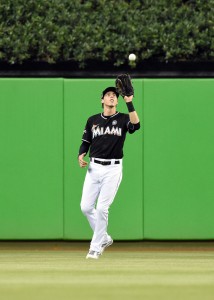The Marlins continue to discuss center fielder Christian Yelich and catcher J.T. Realmuto with other clubs, but there’s “nothing imminent” on the trade front, Mark Feinsand of MLB.com hears (Twitter link). Although the Marlins are in teardown mode, it would reportedly take a “huge overpay” for them to deal either Yelich or Realmuto, their two most valuable assets. The 26-year-old Yelich is controllable through 2022 on one of the majors’ most appealing contracts, while Realmuto (27 in March) is set to play his first of three arbitration-eligible campaigns in 2018. Kyle Downing of MLBTR examined Yelich, Realmuto and the rest of Miami’s trade candidates over the weekend.
More on the Fish and a couple other East Coast franchises:
- Miami traded both Giancarlo Stanton and Marcell Ozuna earlier this offseason, thus subtracting a pair of in-their-prime sluggers who combined for a whopping 96 home runs in 2017. Now, with those two in other uniforms, the organization is “looking for guys who can provide power in the middle of the lineup,” vice president of player development and scouting Gary Denbo told Joe Frisaro of MLB.com. Unsurprisingly, though, the Marlins aren’t competing for high-level free agents who would serve as short-term upgrades, per Frisaro, who writes that “their vision is more long range.”
- With the Red Sox still interested in acquiring Orioles third baseman/shortstop Manny Machado, Ian Browne of MLB.com weighs in on a potential trade between the AL East rivals. Browne senses that the Red Sox don’t want to trade either shortstop Xander Bogaerts or center fielder Jackie Bradley Jr. this offseason, but he concedes that it wouldn’t be a surprise to see the former head to Baltimore as part of a Machado deal. The Red Sox would be losing two years of Bogaerts for a single season of control over Machado. As such, if Boston acquires Machado, it would make an aggressive push to re-up the superstar in order to prevent him from leaving as a free agent next winter, Browne adds.
- The Orioles still face a difficult path, all the more so given that the team will evidently be paying Zach Britton a full arbitration salary for what might be little more than a half season of work. Jon Meoli of the Baltimore Sun writes that, while the rotation market still hasn’t moved much, some of the arms from Baltimore’s potential target demographic are among those that have found new teams. Meanwhile, Steve Melewski of MASNsports.com considers the question of whether the team will look to make second baseman Jonathan Schoop a part of a new long-term core — and, if so, how much it might cost to get something done.
